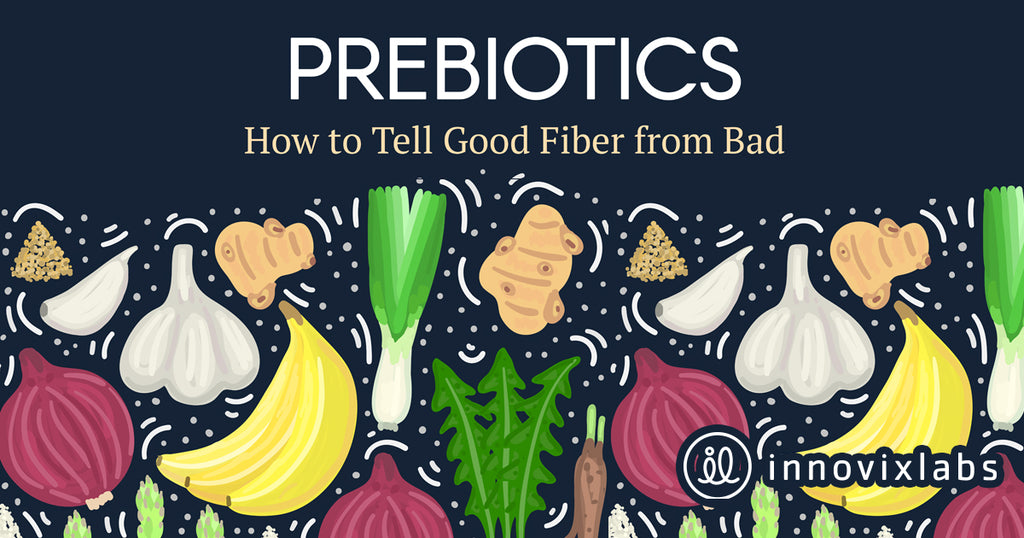
Before we get to prebiotics, what's the difference between PREbiotic and PRObiotic?
Probiotics are good bacteria.
Prebiotics are food for the good bacteria.
A probiotic supplement introduces the specific bugs in the supplement into your gut.
Prebiotics on the other hand, feed all of your gut bugs, so they increase in number and variety.
What's a Prebiotic?
Think of prebiotics as fertilizer for your gut bacteria.
Prebiotics are food ingredients that you cannot digest but your gut bacteria can.
Is Prebiotic just a fancy word for fiber?
No.
We used to think of prebiotics as just fiber, but that definition has evolved to include other non-fiber ingredients.
Are all fibers prebiotics?
No.
There are two major types of fibers: soluble and insoluble.
Soluble fiber
Many soluble fibers are prebiotics.
As the name suggests, if you put a spoonful of it in a glass of water and stir, it will dissolve clear.
- Soluble fiber helps slow down digestion and sugar absorption, so you don't get as sharp a glucose spike after eating.
- Soluble fiber will bind with water in the stomach, forming a gel. This will make you feel full, possibly acting as a mild appetite-suppressant.
- Soluble fiber can interfere with cholesterol absorption and may reduce LDL 'bad' cholesterol.
Prebiotic (soluble) fiber come in several types:
- Resistant Starch are called that because they resist digestion. They are found in oats, raw potato, legumes, and rice that's been cooked and cooled in the fridge.
- XOS (Xylooligosaccharides) is a form of prebiotic from sugarcane.
- Inulin is a type of carbs that gut bugs seem to love. They are found in chicory roots, onions, jerusalem artichokes, green bananas, plantains, and leeks.
- FOS (Fructooligosaccharides) is a well-studied group of prebiotics
- GOS (Galactooligosaccharides) are often made from lactose or plant fibers.
- HMO (Human Milk Oligosaccharides) are a group of prebiotics found in human breast milk. There are literally hundreds of types of fibers found in breast milk, a sign of how important prebiotics are to the developing baby.
- IMO (Isomalto-oligosaccharides) are found in honey and some fermented foods.
Insoluble fiber
Insoluble fiber is roughage. It's what you usually see marketed by breakfast cereals.
They look like clumps, twigs, or beads of tree bark. It's meant to bulk up stool and, uh, help you poop.
They used to taste like they looked, but high-fiber cereals have come a long way.
Breakfast cereal Fiber One is a perfect example: it has 18 grams of fiber per serving.
Yay...right? Not exactly.
Seventeen of those 18 grams are insoluble fiber. Those 17 grams will pass through you completely undigested, giving your body no additional nourishment. Yes, they will help bulk up stool and help you 'go.' That's desperately important to a lot of folks, but there's little benefit beyond that.
Probiotic bacteria cannot use or digest insoluble fiber.
While a little bit of insoluble fiber goes a long way to keep things moving, too much can bind the absorption of some minerals.
If you like breakfast cereals with bran, no harm in eating a little. But don't fool yourself into thinking that you've eaten the right type of fiber.
You're better off eating mostly soluble fiber with a small side of insoluble fiber.
Why? Because most soluble fibers are prebiotics and they help feed your gut bacteria.
Are there non-fiber prebiotics?
Yes.
Polyphenols are the perfect examples.
What are Polyphenols?
Polyphenols are natural chemicals found in plants. There are over 8000 types.
Polyphenols act as natural sunscreen and bug-repellants for plants. Fortunately, your gut bugs love 'em.
We are just starting to understand the importance of polyphenols.
Coffee, tea, red wine are all rich in their own unique blends of polyphenols and it's possible that the benefits of attributed to these beverages are a result of byproducts from gut bugs digesting polyphenols.
If you're concerned about gut health and gut bugs (and you should be!), then, your focus needs to be on foods that contain soluble fiber and polyphenols - these are the fibers and prebiotics you want.
How to get more prebiotics and polyphenols in your diet
Veggies, fruits, nuts, and legumes are rich in soluble prebiotic fibers.
Berries, wine, green tea, coffee, turmeric, pomegranates, cocoa, nuts, apple skin, and spices are all rich in polyphenols.
There's a catch...(actually, two)
The efficacy and health benefits of prebiotics and polyphenols are dependent on two thing:
- Your existing gut microbiome
- Your genetics
This is why you may find our prebiotic does wonders for you, but it may not do much for someone else.
So, that's the catch.
Also, if your gut flora is really messed up (dysbiosis), then, the initial introduction of fermentable fibers may causes some bloating and discomfort.
So it's critical to start slow, especially if you don't consume a lot of veggies.
How do you know if a food product has prebiotics?
The total fiber amount is always listed right under the Carbohydrate content of the food.
Is that the total prebiotic fiber content? No. This is tricky. Why? Because fiber amounts shown on food product label combines soluble (prebiotic) and insoluble (roughage) fiber into one combined fiber number.
So it's impossible to tell how much of the fiber is the prebiotic kind and how much is the roughage kind.
In the US, any product that has 2.5 grams or fiber (10% of daily value) is considered a 'good source' of fiber. That sounds good...but it could be almost all roughage-type fiber.
And that's the second catch.
Bottom-line:
It's generally a bad idea to look for prebiotic fiber in packaged or processed products.
If you want prebiotics, the best sources are vegetables, legumes, nuts, seeds, and berries. If you don't think you eat enough of those, consider a prebiotic supplement.

